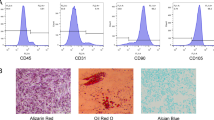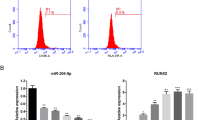Abstract
Autologous bone transplantation which is a common treatment method for bone defects needs a large quantity of bone cells. In order to develop new treatments to regenerating bone tissues, this research aimed at identifying the key genes and finding their mechanism in human adipose-derived stem cells (hADSCs) osteogenesis. GSE63754, GSE89330 and GSE72429 were downloaded to perform GO functional and KEGG pathway analyses, construct a competing endogenous RNA (ceRNA) network, construct a PPI network and identify hub genes. The expression level of LMO3 during the osteogenesis of hADSCs was examined by quantitative reverse transcription polymerase chain reaction and western blot. Lentivirus transfection was used to knock down or overexpress LMO3, which enabled us to investigate the effect of LMO3 on osteogenic differentiation of hADSCs. Wortmannin were used to identify the mechanism of the LMO3/PI3K/Akt axis in regulating osteogenic differentiation of hADSCs. Moreover, ectopic bone formation in nude mice was used to investigate the effect of LMO3 on osteogenesis in vivo. In this study, we found the expression of LMO3 was significantly upregulated during the osteogenic differentiation of hADSCs. LMO3 knockdown remarkably suppressed osteogenic differentiation of hADSCs, while LMO3 overexpression promoted osteogenic differentiation of hADSCs both in vitro and in vivo. Moreover, we discovered that the enhancing effect of LMO3 overexpression on osteogenic differentiation was related to the activation of PI3K/Akt signaling pathway. Inhibition of PI3K/Akt signaling pathway with wortmannin effectively blocked the stimulation of osteogenic differentiation induced by LMO3 overexpression. In conclusion, based on transcriptomic analysis, we identified key genes involved in regulating the osteogenic differentiation of hADSCs. In addition, we found that LMO3 might act as a positive modulator of hADSC osteogenic differentiation by mediating PI3K/Akt signaling pathway. Manipulating the expression of LMO3 and its associated pathways might contribute to advances in bone regeneration and tissue engineering.









Similar content being viewed by others
References
Ahmed LA et al (2021) Boosting Akt pathway by rupatadine modulates Th17/Tregs balance for attenuation of isoproterenol-induced heart failure in rats. Front Pharmacol 12:651150
Ala U et al (2013) Integrated transcriptional and competitive endogenous RNA networks are cross-regulated in permissive molecular environments. Proc Natl Acad Sci USA 110(18):7154–7159
Amin HD, Ethier CR (2016) Differential effects of tyrosine-rich amelogenin peptide on chondrogenic and osteogenic differentiation of adult chondrocytes. Cell Tissue Res 364(1):219–224
Aoyama M et al (2005) LMO3 interacts with neuronal transcription factor, HEN2, and acts as an oncogene in neuroblastoma. Can Res 65(11):4587–4597
Bourin P et al (2013) Stromal cells from the adipose tissue-derived stromal vascular fraction and culture expanded adipose tissue-derived stromal/stem cells: a joint statement of the International Federation for Adipose Therapeutics and Science (IFATS) and the International Society for Cellular Therapy (ISCT). Cytotherapy 15(6):641–648
Bunnell BA et al (2008) Adipose-derived stem cells: isolation, expansion and differentiation. Methods 45(2):115–120
Chen S et al (2020) Identification of the key genes and microRNAs in adult acute myeloid leukemia with FLT3 mutation by bioinformatics analysis. Int J Med Sci 17(9):1269–1280
Cheng C, Wentworth K, Shoback DM (2020) New frontiers in osteoporosis therapy. Annu Rev Med 71:277–288
Chun SY et al (2019) Preparation and characterization of human adipose tissue-derived extracellular matrix, growth factors, and stem cells: a concise review. Tissue Eng Regen Med 16(4):385–393
Daniunaite K et al (2015) Epigenetic regulation of human adipose-derived stem cells differentiation. Mol Cell Biochem 410(1–2):111–120
Dominici M et al (2006) Minimal criteria for defining multipotent mesenchymal stromal cells. The International Society for Cellular Therapy position statement. Cytotherapy 8(4):315–7
Dong R et al (2014) Comparison of long noncoding RNA and mRNA expression profiles in mesenchymal stem cells derived from human periodontal ligament and bone marrow. Biomed Res Int 2014:317853
Dong X et al (2016) GPR39 activates proliferation and differentiation of porcine intramuscular preadipocytes through targeting the PI3K/AKT cell signaling pathway. J Recept Signal Transduct Res 36(2):130–138
Duttenhoefer F et al (2013) 3D scaffolds co-seeded with human endothelial progenitor and mesenchymal stem cells: evidence of prevascularisation within 7 days. Eur Cells Mater 26(4):49–65
Gao F et al (2021) Cornuside I promoted osteogenic differentiation of bone mesenchymal stem cells through PI3K/Akt signaling pathway. J Orthop Surg Res 16(1):397
Gaur M, Dobke M, Lunyak VV (2019) Methods and strategies for procurement, isolation, characterization, and assessment of senescence of human mesenchymal stem cells from adipose tissue. Methods Mol Biol 2045:37–92
Gu X et al (2017) Identification and integrated analysis of differentially expressed lncRNAs and circRNAs reveal the potential ceRNA networks during PDLSC osteogenic differentiation. BMC Genet 18(1):100
Hu C, Zhao L, Li L (2019) Current understanding of adipose-derived mesenchymal stem cell-based therapies in liver diseases. Stem Cell Res Ther 10(1):199
Huang G et al (2017) Identification and characterization of long non-coding RNAs in osteogenic differentiation of human adipose-derived stem cells. Cell Physiol Biochem 42(3):1037–1050
Jia B et al (2019) A feed-forward regulatory network lncPCAT1/miR-106a-5p/E2F5 regulates the osteogenic differentiation of periodontal ligament stem cells. J Cell Physiol 234(11):19523–19538
Kang Y et al (2020) Differential circular RNA expression profiling during osteogenic differentiation in human adipose-derived stem cells. Epigenomics 12(4):289–302
Kanis JA et al (2019) European guidance for the diagnosis and management of osteoporosis in postmenopausal women. Osteoporos Int 30(1):3–44
Li W et al (2019) Comprehensive bioinformatics analysis of acquired progesterone resistance in endometrial cancer cell line. J Transl Med 17(1):58
Liu T et al (2021) Advances of adipose-derived mesenchymal stem cells-based biomaterial scaffolds for oral and maxillofacial tissue engineering. Bioact Mater 6(8):2467–2478
Meng Q et al (2006) Role of PI3K and AKT specific isoforms in ovarian cancer cell migration, invasion and proliferation through the p70S6K1 pathway. Cell Signal 18:2262–2271
Park JS et al (2020) Osteoporotic conditions influence the activity of adipose-derived stem cells. Tissue Eng Regen Med 17(6):875–885
Paspaliaris V, Kolios G (2019) Stem cells in osteoporosis: from biology to new therapeutic approaches. Stem Cells Int 2019:1730978
Peltier J et al (2007) PI3K/Akt and CREB regulate adult neural hippocampal progenitor proliferation and differentiation. Dev Neurobiol 67:1348–1361
Salmena L et al (2011) A ceRNA hypothesis: the Rosetta Stone of a hidden RNA language? Cell 146(3):353–358
Si L et al (2015) Projection of osteoporosis-related fractures and costs in China: 2010–2050. Osteoporos Int 26(7):1929–1937
Sorger JI et al (2001) Allograft fractures revisited. Clin Orthop Relat Res 382:66–74
Sun W et al (2019) Resveratrol inhibits human visceral preadipocyte proliferation and differentiation in vitro. Lipids 54(11–12):679–686
Tang XL et al (2017) Protein tyrosine phosphatase SHP-1 modulates osteoblast differentiation through direct association with and dephosphorylation of GSK3β. Mol Cell Endocrinol 439:203–212
Vos T et al (2020) Global burden of 369 diseases and injuries in 204 countries and territories, 1990–2019: a systematic analysis for the Global Burden of Disease Study 2019. Lancet 396(10258):1204–1222
Wagner G et al (2021) LMO3 reprograms visceral adipocyte metabolism during obesity. J Mol Med (berl) 99(8):1151–1171
Wang L et al (2015) Differential expression of long noncoding ribonucleic acids during osteogenic differentiation of human bone marrow mesenchymal stem cells. Int Orthop 39(5):1013–1019
Wu Z et al (2020) Immunomodulatory effects of mesenchymal stem cells for the treatment of cardiac allograft rejection. Exp Biol Med (Maywood). https://doi.org/10.1177/1535370220978650
Xie Y et al (2019) PI3K/Akt signaling transduction pathway, erythropoiesis and glycolysis in hypoxia. Mol Med Rep 19(2):783–791
Yang B et al (2021) Selenium attenuates ischemia/reperfusion injury-induced damage to the blood-brain barrier in hyperglycemia through PI3K/AKT/mTOR pathway-mediated autophagy inhibition. Int J Mol Med 48(3):178
Funding
This study was supported by the Joint Funds of the Natural science Foundation of Liaoning Province, Grant Number 2020-ZLLH-40.
Author information
Authors and Affiliations
Corresponding author
Ethics declarations
Conflict of interest
The authors declare that they have no conflict of interest.
Ethical approval
All experimental procedures involving animals were done in accordance with the Guide for the Care and Use of Laboratory Animals and the institutional ethical guidelines for animal experiments.
Informed consent
Not applicable.
Additional information
Publisher's Note
Springer Nature remains neutral with regard to jurisdictional claims in published maps and institutional affiliations.
Rights and permissions
About this article
Cite this article
Kang, Y., Pei, W. Transcriptomic analysis and biological evaluation reveals that LMO3 regulates the osteogenic differentiation of human adipose derived stem cells via PI3K/Akt signaling pathway. J Mol Histol 53, 379–394 (2022). https://doi.org/10.1007/s10735-021-10047-5
Received:
Accepted:
Published:
Issue Date:
DOI: https://doi.org/10.1007/s10735-021-10047-5




